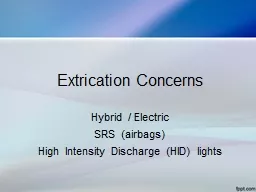

Hybrid Electric SRS airbags High Intensity Discharge HID lights Hybrid and Electric Vehicles Have Parallel Electric Systems 12 Volt High Voltage DC 110220 AC 12V system controls ignition lighting radio ID: 238346
Download Presentation The PPT/PDF document "Extrication Concerns" is the property of its rightful owner. Permission is granted to download and print the materials on this web site for personal, non-commercial use only, and to display it on your personal computer provided you do not modify the materials and that you retain all copyright notices contained in the materials. By downloading content from our website, you accept the terms of this agreement.
Slide1
Extrication Concerns
Hybrid / Electric
SRS (airbags)
High Intensity Discharge (HID) lightsSlide2
Hybrid and Electric Vehicles
Have Parallel Electric Systems
12 Volt
High Voltage DC + 110/220 AC
12V system controls: ignition, lighting, radio
AC voltage is strictly for propulsion and other motorized requirements (AC, power steering)
WARNING
A silent car is not necessarily off.
Look at the dash/gages
Turn Key off when possible
KEY FACT
12V system controls relays in the high voltage battery system. Removing 12V power opens these relays and disables electric propulsion system.Slide3
Supplemental Restraint System
(SRS or airbag system)
Composed of four major components:
Sensors
Impact
Speed
Deceleration/ Accelerometers
Processing Unit
12V Power system
AirbagsSlide4
SRS cont.
Basic Functionality
Processing Unit causes one or more airbags to discharge based upon sensor inputs.
No single input can trigger a discharge
Parked cars that are hit do not discharge airbags
No
accel
/
decel
or speed input
Sudden stop of itself does dot trigger airbag
No impact
WARNING
c
ompressed gas cylinders remain a concern for cutting. Peel before you cut.
KEY FACT
Turning key off and disconnecting 12V safely disables SRS airbag deployment.Slide5
HID Lights
Same operation as Arc lights – Arc is generated across a gas (xenon) that is excited by the arc
Voltage is stepped up from 12V to 20,000V by the igniter to ignite the arc and 85V from the ballast to keep it active.
HID produce more light because the energy is released as light and not heat.
The voltage step up is similar to the process used by
tasers
. Allows low volt power source (i.e. 9V battery) to increase to 5000V.
KEY FACT
HID lights are potential electrocution hazards and fire/ignition hazards.Slide6
Takeaways
All vehicles on the road today have a 12V system with a battery.
All systems of concern can be safely disabled by removing the 12V battery from the circuit.
Hybrid Electric Vehicle concerns are reduced to common concerns.
Slight variation in our current procedure can address all concernsSlide7
MVC Procedure E9-1
First due apparatus
Key goals:
size up and scope of the incident
Number of vehicles
Number of patients
Hazards (power, water, fuel, stability)
Scene safety / containment
determine need for extrication
stabilize vehicles
PT contact / prioritization (triage)
Extrication as neededSlide8
E9-1 En Route
Determine approach options (if any)
Determine
personell
roles (EMT =
pt
care)
Listen for updates and other responding unitsSlide9
E9-1 On Scene
DO and Officer discuss placement
Park to protect the scene
Size up for dangers that may increase distance (down power lines/poles, hazmat, livestock, etc.)
Determine priority vehicle for stabilization
Individual roles
Line selection
Fully Packed
up and on air before approaching vehiclesSlide10
E91 D.O.
Park apparatus as decided
Engage pump
Engage
compressor (
autobalance
or fixed)
Foam on
Open
tank to pump and re-
circ
valves
Set
wheel chocks
Start generator
Set Cones (if time)
Charge attack line when requested
Man the attack line when flow is established by nozzle.
When relieved, set cones and man engine.Slide11
E9-1 Crew Leader
On Scene Size up and establish IC as needed
Perform walk around of incident
all the way around if possible
check under vehicles
direct crew to place chocks
PT access as possible
Put vehicle in Park
Set emergency brake if possible.
Maximize PT access by using all electrical switches available (unlock doors, pop hood and trunk, windows down. Move electric seats if possible.
Turn key off – remove
Turn headlights off
Turn hazards on
Give crew OK to disconnect battery
Off air / doff packs if hazards clearSlide12
E9-1 Nozzle
Stretch chosen line to safe distance with optimal coverage.
Get line charged and verify flow.
Give hand line to DO
Retrieve small MVA bag from engine and any remaining chocks/cribbing as needed.
Work with Tools/CL to stabilize, deflate tires
CL may divert to PT care
Get OK from CL to disconnect battery
Work with Tools to gain access to battery and disengage
If no battery access, clip wires from main fuse block
Confirm Hazards off
Doff packs?
Continue with extrication /
t
ool deployment as neededSlide13
E9-1 Tools
Obtain Irons (
halligan
& axe)
Obtain step chocks and set on the primary vehicle
Work with Nozzle to get chocks set and tires deflated on all vehicles.
CL may divert to PT care
When CL OK’s, gain access to Battery
Confirm hazards off
Doff packs?
Continue with tool deployment / extrication as needed.Slide14
Rescue 9-11
Second due apparatus
Park out of traffic and outside the scene or inside the scene if access affords.
IC will direct to pack up or not
IC will direct to either PT care, extrication, or other needs
Most likely PT care
Bring forward med bags,
backboards, towel rolls
Obtain the IC or CL plan for extrication, primary vehicle and primary PT designation.Slide15
Command 9 (Officer POV)
Second or third due apparatus
Park to minimize traffic exposure and scene obstruction.
If first on scene, establish IC, size up, Consider 360?
If second On Scene assume IC
Get incident overview from CL
PT count
Extrication efforts and needs
Other needs
Safety
concerns
What is the current plan and objective
Consider secondary survey for ejected or mobile
PTs.Slide16
T9-5/ T9-4
Third or fourth due apparatus
Park to protect the scene and extend scene
If no extrication or PT care needs, set more cones and assist with traffic control.